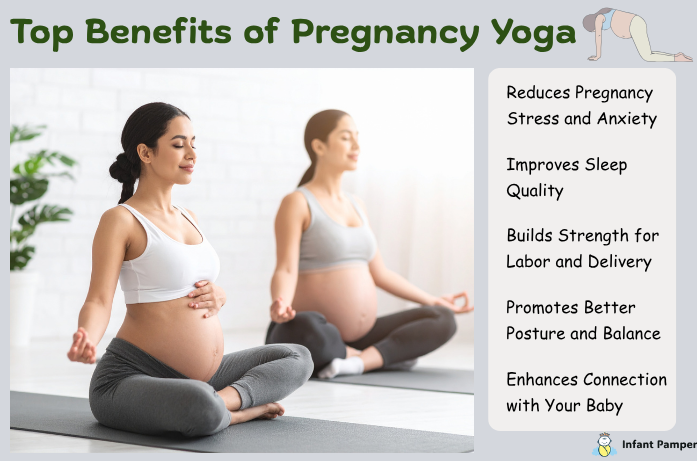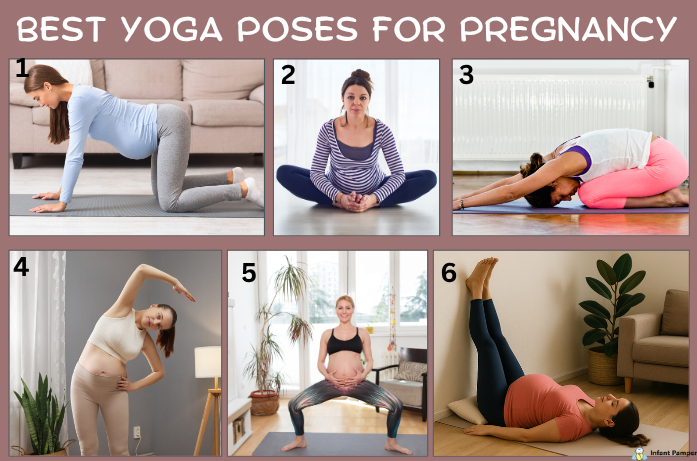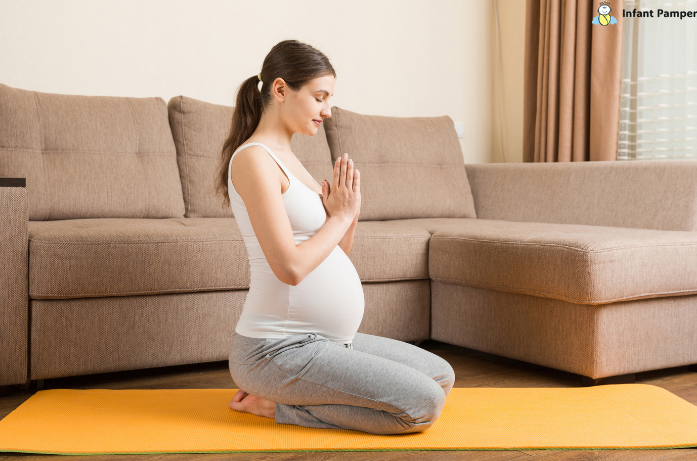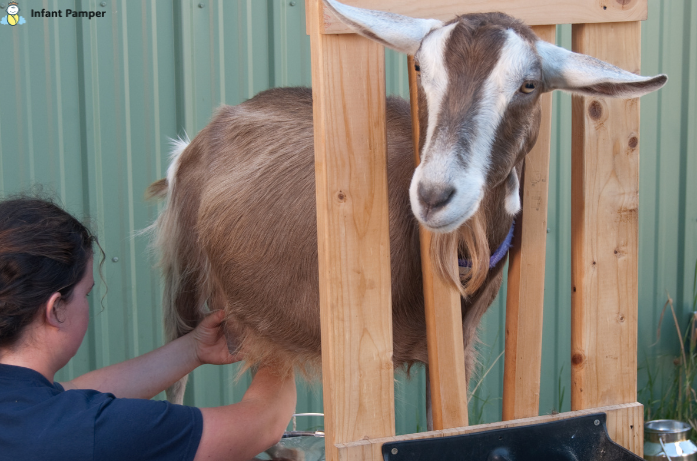By a Caring Mom at Infant Pamper
Pregnancy ranks among the most thrilling and transforming adventures that a woman can go through. However, to tell the truth, it also brings along discomforts, temperament changes, and nights with little or no sleep. The question now is how to keep oneself calm, healthy, and mentally stable throughout this period?
Pregnancy yoga, also called prenatal yoga, is one of the safest and most effective ways to support your body and mind throughout all stages of pregnancy. Backed by research and trusted by millions of mothers worldwide, it helps reduce stress, ease pain, and prepare your body for childbirth.
Whether you’re a beginner or already familiar with yoga, this comprehensive guide will help you understand the benefits, explore safe yoga poses, and follow the most important safety tips. Let’s begin.
What is Pregnancy Yoga?
Pregnancy yoga is a gentle, modified form of traditional yoga that is specifically designed to meet the needs of pregnant women. Unlike regular yoga, it avoids deep twists, high-impact movements, or any poses that compress the belly.
The main points are:
- Breathing exercises (to handle labor and stress)
- Gentle stretching (to relax tense muscles)
- Comforting positions (to increase strength and flexibility)
- Mindfulness and relaxation (to maintain emotional stability)
Prenatal yoga is fit for the entire nine months, and the majority of classes are suited for beginners. It can be taken in a studio or through a video call if an experienced instructor is available.

Top Benefits of Pregnancy Yoga
So, let’s make a list of the essential physical, emotional, and mental Benefits that are supported by personal experience and research of the experts.
1. Reduces Pregnancy Stress and Anxiety
Pregnancy is a time of often hormonal changes, uncertainty, and emotional roller coasters. Breathing deeply and meditating in yoga stimulate the parasympathetic nervous system (the body’s relaxation mode), thus helping to calm anxiety and stabilize mood.
The National Institutes of Health (NIH) report that yoga can lower stress hormones such as cortisol and hence, enhance emotional health.
2. Improves Sleep Quality
Insomnia and agitation are prevalent complaints, particularly during the mid and late pregnancy. Continuous practice of prenatal yoga leads to a more relaxed nervous system and less physical tension, which in turn, makes falling and staying asleep easier.
3. Reduces common discomforts
Pregnancy causes dramatic physical changes, most of which come with discomforts like:
- Lower back pain
- Swelling of the feet and ankles
- pressure in the pelvic area
- Shortness of breath
Some of the yoga postures can stretch and soothe the overstretched muscles, and thus, enhance blood flow, and decrease the stress on your joints and ligaments.
4. Builds Strength for Labor and Delivery
Warrior II and Goddess Pose not only strengthen the legs but also the muscles of the hips and pelvic floor, which all are very important during labor and postpartum recovery.
5. Promotes Better Posture and Balance
Your gravity center changes as your belly enlarges. Yoga helps stabilize your core and increase your body awareness, thus preventing strain and improving your overall balance.
6. Connection with the Baby is Enhanced
Yoga, having mindfulness and deep breathing, develops a tranquil environment for you to tune into and feel your baby’s movements as well as your own changing body. Moreover, a number of mothers have reported that they feel more connected emotionally and bonded through their yoga practice.
Is Pregnancy Yoga Safe?
Certainly, if done right and with your doctor’s blessing, prenatal yoga is mostly very safe. It’s a non-strenuous physical activity that is recommended by numerous medical practitioners, such as the American College of Obstetricians and Gynecologists (ACOG).
ACOG suggests 150 minutes of moderate-intensity exercise every week during pregnancy, and yoga is one of the top options.

Best Yoga Poses for Pregnancy (Trimester-Safe)
Some gentle yet effective yoga postures that you can practice at home or in a class are given below. These are safe for all trimesters unless otherwise specified. As explained by Narayana Health, gentle poses like this can help improve circulation, reduce swelling, and bring a sense of relaxation during pregnancy.
1. Cat-Cow Stretch (Marjaryasana-Bitilasana)
Back pain relief, spine strengthening, and posture improvement.
- Begin on all fours
- Inhale: Arch your back, lift chest (cow)
- Exhale: Round your back, tuck chin (cat)
- Repeat slowly for 1–2 minutes
2. Bound Angle Pose (Baddha Konasana)
Opens hips and increases blood circulation to the pelvic area.
- Sit with the soles of your feet together and knees dropped out to sides
- Hold your feet and sit up straight
- Stay for 1–3 minutes, breathe deeply
3. Child’s Pose (Balasana)
A soothing pose to release tension in the back and hips.
- Kneel on the floor with big toes together
- Widen your knees
- Stretch the arms forward and place the forehead on the floor
- Stay for half a minute to one minute
4. Warrior II (Virabhadrasana II)
Helps to develop the muscles of the legs and gives a hand in balancing.
- Widen your stance
- Point one foot outwards and flex the front leg
- Stretch the arms in the direction opposite to each other
- Repeat on the other side after 5-6 breaths
5. Goddess Pose (Utkata Konasana)
Expands the buttocks and pelvic area and is an excellent preparation for delivery.
- Position with an open stance, feet turned out
- Bend legs and gradually lower the body
- Place hands at the heart center or raise them up
- Keep for 3-5 breaths
6. Legs Up the Wall (Viparita Karani)
A posture of comfort that alleviates the swelling of feet and legs.
- Rest on the back and let the legs lie against the wall
- Put a pillow under the hips for added comfort
- Remain in this position for 5-10 minutes, breathing slowly
Poses to Avoid During Pregnancy
A few standard yoga postures are unsafe during the course of pregnancy. Avoid them:
- Deep abdominal twists
- Lying straight on your back after the first trimester
- High-impact balancing poses
- Hot yoga or heated classes
- Any asana that makes you uncomfortable or causes pressure on the abdomen
When you are not sure, ask a certified prenatal yoga trainer or your healthcare professional.
Important Safety Tips for Practicing Pregnancy Yoga
- Always Check With Your Doctor First
Not all pregnancies are the same. In case you suffer from a high-risk pregnancy, placenta previa, or any other complications, it is best to get a doctor’s approval before proceeding with the yoga practice. - Stay Hydrated
Drink water before, during, and after your session. - Use Props for Support
Poses can become safe and more comfortable if bolsters, cushions, yoga blocks, and chairs are used. - Do Not Overstretch
Relaxin, the pregnancy hormone, loosens the joints, making them a little bit more vulnerable. Therefore, be patient and do not push into any stretch. - Make Breathing a Priority
Don’t ever hold your breath. Practice deep, abdominal breathing to remain relaxed and allow the oxygen flow to your body. - Don’t Push Through Pain
If something feels off, quit. Little discomfort is acceptable, but pain is not.
When Can You Start Prenatal Yoga?
If everything is fine and the doctor gives you the green light, you can start prenatal yoga in the first trimester or in fact, as early as the first trimester. The majority of women practice yoga in the second trimester when the morning sickness has gone.
If you have no yoga experience, don’t be worried believing it is too late to start, the most important thing is to take it slow and to be consistent.
Can I Do Yoga at Home?
Yes, many women prefer to practice online prenatal yoga. Look for:
- Trainers who are certified in prenatal yoga
- Videos that are created for each trimester
- Gentle, slow sequences with modification and variation
However, if you are unfamiliar with yoga, you might want to take a few group classes to be instructed on how to do the postures correctly and how to breathe.
Medical Disclaimer: The purpose of this article is to inform only and it is not a substitute for the medical advice of a professional. Always get your doctor’s or midwife’s opinion before engaging in any new physical activity during pregnancy.
FAQs
1. Is yoga safe during pregnancy?
In general, prenatal yoga is safe for almost all women. However, if you have a high-risk pregnancy, it is always advisable to speak with your doctor first.
2. Can beginners do pregnancy yoga?
Yes, prenatal yoga is beginner-friendly as it consists of gentle movements that are suitable for all levels of fitness, including those who are new to yoga.
3. Which yoga poses should I avoid?
Avoid deep twists, belly-down poses, lying flat on your back after the first trimester, and any movement that feels uncomfortable.
4. What is the frequency of yoga sessions I should attend during pregnancy?
The best frequency is 2 to 3 times a week. Even very short sessions, like 20 minutes, can be really helpful in relieving discomfort and improving health.
5. Do I need special equipment for yoga?
Not necessarily. A Not really. A mat, a cushion, and water will suffice. Yoga blocks or bolsters are up to you, but they are good for providing extra support if you want it.
Final Thoughts
Prenatal yoga is a great way to open a peaceful space where you can connect with yourself and your baby growing inside you on the physical, emotional, and spiritual levels. Just 15–20 minutes a day can significantly improve your mood.
So, inhale deeply, unroll your mat, and keep in mind: what you’re doing is very beautiful, for both of you.
Would you like to receive more tips on prenatal wellness and baby-friendly advice?
Subscribe to Infant Pamper and get daily updates, nutrition guides, and expert-backed parenting content, straight to your inbox.




